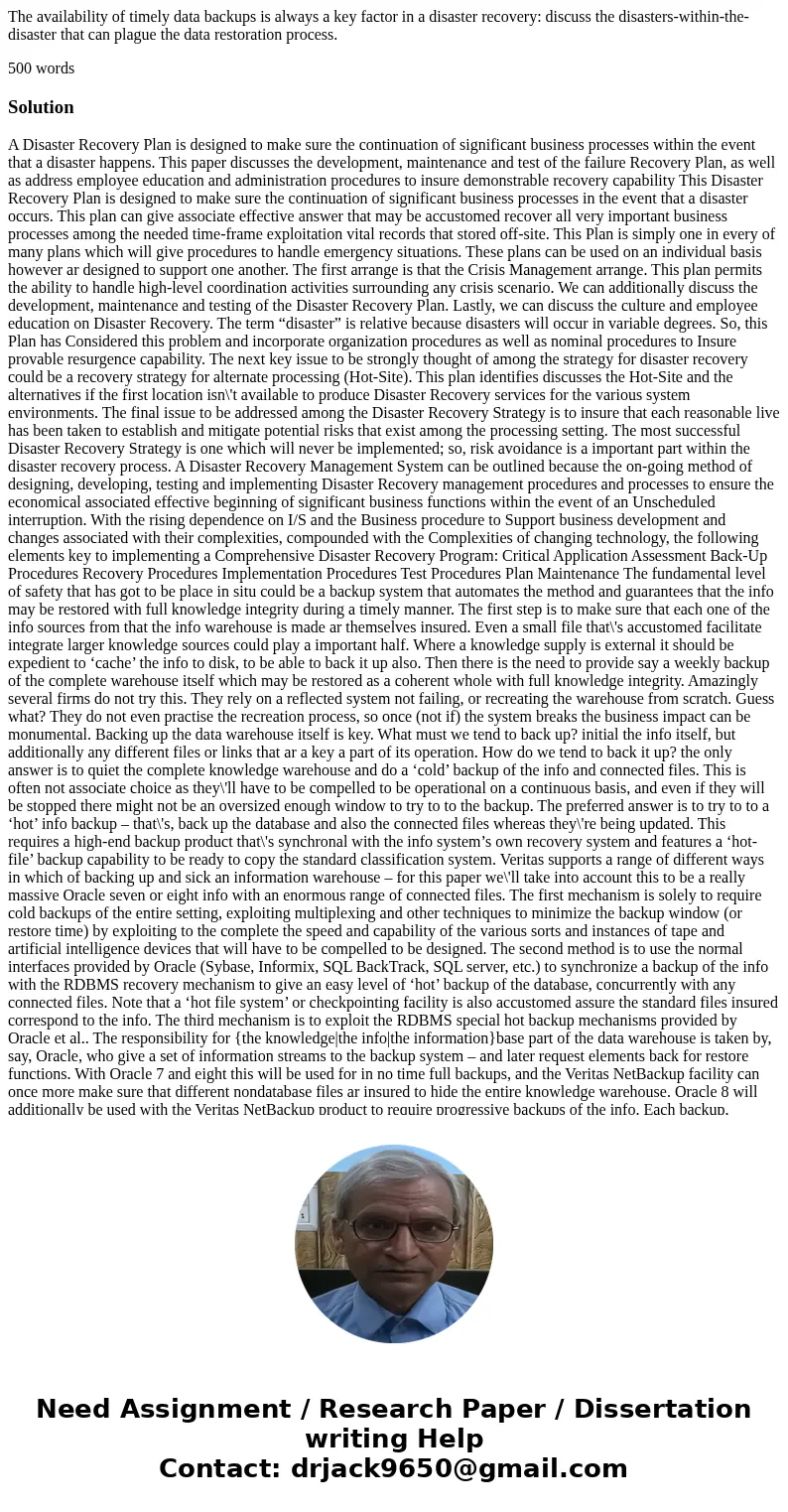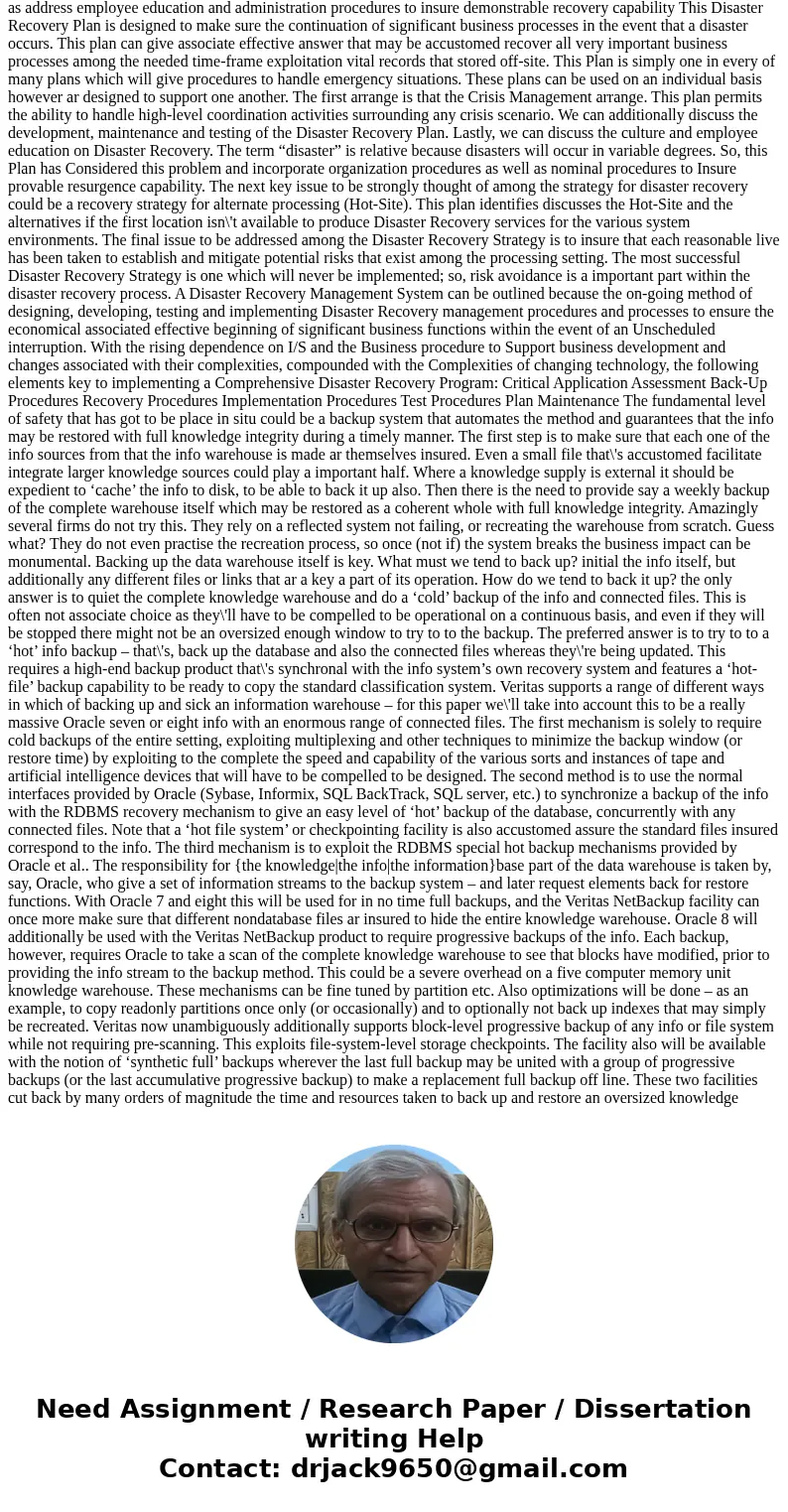The availability of timely data backups is always a key fact
The availability of timely data backups is always a key factor in a disaster recovery: discuss the disasters-within-the-disaster that can plague the data restoration process.
500 words
Solution
A Disaster Recovery Plan is designed to make sure the continuation of significant business processes within the event that a disaster happens. This paper discusses the development, maintenance and test of the failure Recovery Plan, as well as address employee education and administration procedures to insure demonstrable recovery capability This Disaster Recovery Plan is designed to make sure the continuation of significant business processes in the event that a disaster occurs. This plan can give associate effective answer that may be accustomed recover all very important business processes among the needed time-frame exploitation vital records that stored off-site. This Plan is simply one in every of many plans which will give procedures to handle emergency situations. These plans can be used on an individual basis however ar designed to support one another. The first arrange is that the Crisis Management arrange. This plan permits the ability to handle high-level coordination activities surrounding any crisis scenario. We can additionally discuss the development, maintenance and testing of the Disaster Recovery Plan. Lastly, we can discuss the culture and employee education on Disaster Recovery. The term “disaster” is relative because disasters will occur in variable degrees. So, this Plan has Considered this problem and incorporate organization procedures as well as nominal procedures to Insure provable resurgence capability. The next key issue to be strongly thought of among the strategy for disaster recovery could be a recovery strategy for alternate processing (Hot-Site). This plan identifies discusses the Hot-Site and the alternatives if the first location isn\'t available to produce Disaster Recovery services for the various system environments. The final issue to be addressed among the Disaster Recovery Strategy is to insure that each reasonable live has been taken to establish and mitigate potential risks that exist among the processing setting. The most successful Disaster Recovery Strategy is one which will never be implemented; so, risk avoidance is a important part within the disaster recovery process. A Disaster Recovery Management System can be outlined because the on-going method of designing, developing, testing and implementing Disaster Recovery management procedures and processes to ensure the economical associated effective beginning of significant business functions within the event of an Unscheduled interruption. With the rising dependence on I/S and the Business procedure to Support business development and changes associated with their complexities, compounded with the Complexities of changing technology, the following elements key to implementing a Comprehensive Disaster Recovery Program: Critical Application Assessment Back-Up Procedures Recovery Procedures Implementation Procedures Test Procedures Plan Maintenance The fundamental level of safety that has got to be place in situ could be a backup system that automates the method and guarantees that the info may be restored with full knowledge integrity during a timely manner. The first step is to make sure that each one of the info sources from that the info warehouse is made ar themselves insured. Even a small file that\'s accustomed facilitate integrate larger knowledge sources could play a important half. Where a knowledge supply is external it should be expedient to ‘cache’ the info to disk, to be able to back it up also. Then there is the need to provide say a weekly backup of the complete warehouse itself which may be restored as a coherent whole with full knowledge integrity. Amazingly several firms do not try this. They rely on a reflected system not failing, or recreating the warehouse from scratch. Guess what? They do not even practise the recreation process, so once (not if) the system breaks the business impact can be monumental. Backing up the data warehouse itself is key. What must we tend to back up? initial the info itself, but additionally any different files or links that ar a key a part of its operation. How do we tend to back it up? the only answer is to quiet the complete knowledge warehouse and do a ‘cold’ backup of the info and connected files. This is often not associate choice as they\'ll have to be compelled to be operational on a continuous basis, and even if they will be stopped there might not be an oversized enough window to try to to the backup. The preferred answer is to try to to a ‘hot’ info backup – that\'s, back up the database and also the connected files whereas they\'re being updated. This requires a high-end backup product that\'s synchronal with the info system’s own recovery system and features a ‘hot-file’ backup capability to be ready to copy the standard classification system. Veritas supports a range of different ways in which of backing up and sick an information warehouse – for this paper we\'ll take into account this to be a really massive Oracle seven or eight info with an enormous range of connected files. The first mechanism is solely to require cold backups of the entire setting, exploiting multiplexing and other techniques to minimize the backup window (or restore time) by exploiting to the complete the speed and capability of the various sorts and instances of tape and artificial intelligence devices that will have to be compelled to be designed. The second method is to use the normal interfaces provided by Oracle (Sybase, Informix, SQL BackTrack, SQL server, etc.) to synchronize a backup of the info with the RDBMS recovery mechanism to give an easy level of ‘hot’ backup of the database, concurrently with any connected files. Note that a ‘hot file system’ or checkpointing facility is also accustomed assure the standard files insured correspond to the info. The third mechanism is to exploit the RDBMS special hot backup mechanisms provided by Oracle et al.. The responsibility for {the knowledge|the info|the information}base part of the data warehouse is taken by, say, Oracle, who give a set of information streams to the backup system – and later request elements back for restore functions. With Oracle 7 and eight this will be used for in no time full backups, and the Veritas NetBackup facility can once more make sure that different nondatabase files ar insured to hide the entire knowledge warehouse. Oracle 8 will additionally be used with the Veritas NetBackup product to require progressive backups of the info. Each backup, however, requires Oracle to take a scan of the complete knowledge warehouse to see that blocks have modified, prior to providing the info stream to the backup method. This could be a severe overhead on a five computer memory unit knowledge warehouse. These mechanisms can be fine tuned by partition etc. Also optimizations will be done – as an example, to copy readonly partitions once only (or occasionally) and to optionally not back up indexes that may simply be recreated. Veritas now unambiguously additionally supports block-level progressive backup of any info or file system while not requiring pre-scanning. This exploits file-system-level storage checkpoints. The facility also will be available with the notion of ‘synthetic full’ backups wherever the last full backup may be united with a group of progressive backups (or the last accumulative progressive backup) to make a replacement full backup off line. These two facilities cut back by many orders of magnitude the time and resources taken to back up and restore an oversized knowledge

 Homework Sourse
Homework Sourse